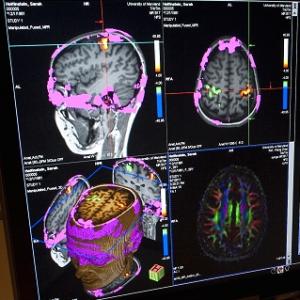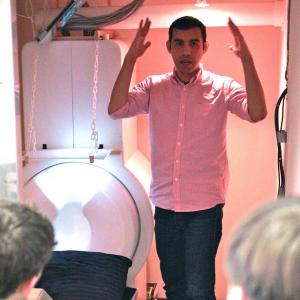Research Facilities
Language scientists at the University of Maryland have access to world-class research facilities. Thanks to collaboration and widespread sharing of lab facilities, researchers can combine multiple methods in their research, and are free to use whichever methods suit their current questions, rather than choosing questions that fit the tools of a single lab.
Behavioral Labs
Many research labs on campus carry out behavioral studies using judgment and reaction time paradigms. Different measures are used to answer questions about the learning, representation, and processing of language. These include lexical decision, self-paced reading, artificial grammar learning, truth-value judgment, magnitude estimation, and speed-accuracy tradeoff. The low technical overhead of these methods also makes them excellent for cross-linguistic research that requires testing abroad, and Maryland language scientists have conducted "experimental fieldwork" in many countries, including India, China, Sweden, Russia, Argentina, Japan, and Brazil.
Eye-tracking
Recent advances in tools for measuring eye- movements have led to many important findings about the time course of language understanding in children and adults. Maryland's language science labs have two EyeLink 1000 eye-trackers (Linguistics, Psychology) that are ideal for studies of reading, and an ASL Remote eye-tracker (Linguistics) that is ideal for visual world studies with children and adults. The two eye-trackers housed in Linguistics are community resources that are available to researchers from multiple departments.
Electroencephalography (EEG)
The Cognitive Neuroscience of Language Laboratory (Linguistics) includes an EEG lab that allows recording at 32-128 locations across the scalp. EEG measures scalp voltages associated with underlying neural activity, and provides millisecond resolution information about the timing of brain processes.
Magnetoencephalography (MEG)
The Maryland Neuroimaging Center (MNC) houses a research-dedicated magnetoencephalography device. The scanner consists of an array of 160 ultra-sensitive magnetic field detectors that surround the scalp, allowing recording of the minute magnetic fields that are generated by the electrical activity of neurons in the brain. MEG recordings make it possible to localize dynamic neural activity with millisecond precision.
Magnetic Resonance Imaging (MRI)
Also housed at the Maryland Neuroimaging Center (MNC) is a state-of-the-art magnetic resonance imaging (MRI) scanner (3T Siemens Trio) that is dedicated to cognitive neuroscience research, including studies with developmental populations. MRI is ideally suited for non- invasively studying brain structure and the localization of brain functions and neural connectivity.
Infant and Child Studies
Infant and Child Studies is a group of researchers and laboratories in Linguistics, Hearing & Speech Sciences, Human Development & Quantitative Methodology, and Psychology that are dedicated to the study of cognitive processes in young children. The labs in the consortium bring around 2000 families per year to the College Park campus to participate in research studies.
Lab Preschool
Research on language development in the critical preschool years benefits from a long-standing partnership with the Center for Young Children, an on-campus lab preschool with 120 children aged 3-6 years, plus other testing arrangements with local (pre-)schools.








